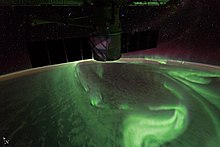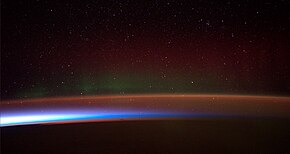মেৰুপ্ৰভা

মেৰুপ্ৰভা (aurora) পৃথিৱীৰ দুই মেৰু অঞ্চলৰ (দৰাচলতে দুই চুম্বকীয় মেৰুৰ) ওপৰৰ বায়ুমণ্ডলত দেখা পোৱা ধেনুভিৰীয়া উজ্জ্বল আভা।
মেৰুপ্ৰভাৰ পোহৰ বগা, ৰঙা, সেউজীয়া, হালধীয়া আৰু নীলা হ'ব পাৰে। অৱশ্যে ৰঙা, সেউজীয়া ৰঙৰ প্ৰাধান্য কিছু বেছি। সুৰ্যৰ পৰা অহা আধানযুক্ত কণিকাবোৰে (বা মহাজাগতিক ৰশ্মিয়ে) পৃথিৱীৰ চৌম্বক ক্ষেত্ৰৰ প্ৰভাৱত সৰ্পিল পথেৰে মেৰুৰ ফালে গতি কৰে। এই গতিপথত সিহঁতে বায়ুমণ্ডলৰ অন্যান্য অণু-পৰমাণুবোৰক খুন্দিয়াই উত্তেজিত কৰে আৰু কেতিয়াবা আয়নিতো কৰে। এনে অনু-পৰমাণুবোৰে শক্তি বিকিৰণ কৰে আৰু এই বিকিৰিত শক্তিয়ে ভূ-চুম্বকৰ দুয়ো মেৰুৰ ফালে মনোমোহা পোহৰৰ সৃষ্টি কৰে।
মেৰুপ্ৰভা ভূ-পৃষ্ঠৰ ওপৰৰ প্ৰায় ৮০ কিলোমিটাৰ ওপৰৰ পৰা ৯৬০ কিলোমিটাৰ ওপৰলৈকে দেখা যায়। সৌৰ শিখা (Solar Flares) সৃষ্টি হোৱাৰ সময়ত সূৰ্যই সাধাৰণ অৱস্থাতকৈ বহু বেছি পৰিমাণৰ আধানযুক্ত কণিকা নিৰ্গত কৰে। ফলত সেই সময়ত মেৰুপ্ৰভা তীব্ৰ হৈ উঠা দেখা যায়। উত্তৰ মেৰুৰ ওচৰত দেখা মেৰুপ্ৰভাক সুমেৰু প্ৰভা (Aurora Borealis) আৰু দক্ষিণ মেৰুৰ ফালে দৃশ্যমান মেৰুপ্ৰভাক কুমেৰুপ্ৰভা (Aurora Australis) বুলি কোৱা হয়। ১৭৭৩ চনত কেপ্টেইন জেমছ কুকে মেৰু অভিযানৰ সময়ত মেৰুপ্ৰভা দেখি, পৃথিৱীৰ আন অংশৰ মানুহক এই সম্বন্ধে জানিবলৈ দিয়ে। সৌৰজগতৰ বেছিভাগ গ্ৰহ, কিছুমান প্ৰাকৃতিক উপগ্ৰহ, বাদামী বামন, আনকি ধুমকেতুত মেৰুপ্ৰভা দেখা যায়।
ব্যুৎপত্তি[সম্পাদনা কৰক]
গেলিলিওৱে ১৬১৯ চনত অৰোৰা ব'ৰিয়েলিছ শব্দটো ৰোমান ভোৰ দেৱী অৰোৰাৰ আৰু উত্তৰ বতাহৰ গ্ৰীক নাম ব'ৰিয়াছৰ পৰা উদ্ভাৱন কৰিছিল।[2][3] অৰোৰা শব্দটো ৰোমান ভোৰ দেৱী অৰোৰাৰ নামৰ পৰা উদ্ভৱ হৈছে, যিয়ে পূবৰ পৰা পশ্চিমলৈ গৈ সূৰ্য্যৰ আগমনৰ ঘোষণা কৰিছিল।[4] প্ৰাচীন গ্ৰীক কবিসকলে ভোৰক বুজাবলৈ সংশ্লিষ্ট নাম ইঅ'ছ ব্যৱহাৰ কৰিছিল আৰু নিশাৰ আকাশৰ ওপৰেৰে ৰঙৰ খেলৰ কথা প্ৰায়ে উল্লেখ কৰিছিল। ৰোমান ভোৰ দেৱীক "গোলাপী আঙুলিৰ ভোৰ" বুলিও কোৱা হয়।[5]
গ্ৰীক-ৰোমান পৌৰাণিক কাহিনীত প্ৰাচীন দেৱতাৰ নামৰ উত্তৰ বতাহ (Boreas) আৰু দক্ষিণ বতাহ (Auster)ৰ পৰা ব’ৰিয়ালিছ আৰু অষ্ট্ৰেলিছ শব্দৰ উৎপত্তি হৈছে।
সংঘটন[সম্পাদনা কৰক]

বেছিভাগ অৰোৰা "অৰ'ৰেল জ'ন" নামেৰে জনাজাত এটা বেণ্ডত দেখা যায়,[6] যিটো সাধাৰণতে অক্ষাংশত ৩°ৰ পৰা ৬° (প্ৰায় ৩৩০–৬৬০ কিলোমিটাৰ) বহল আৰু ভূ-চুম্বকীয় মেৰুৰ পৰা ১০° আৰু ২০°ৰ ভিতৰত সকলো স্থানীয় সময়ত (বা দ্ৰাঘিমাংশ), ৰাতি আন্ধাৰ আকাশৰ বিপৰীতে আটাইতকৈ স্পষ্টকৈ দেখা যায়। বৰ্তমান অৰোৰা প্ৰদৰ্শন কৰা অঞ্চলটোক "অৰ'ৰেল অভাল" বোলা হয়, যিটো সৌৰ বতাহৰ দ্বাৰা পৃথিৱীৰ নিশাৰ ফালে স্থানান্তৰিত হোৱা এটা বেণ্ড।[7] ভূ-চুম্বকীয় সংযোগৰ প্ৰাৰম্ভিক প্ৰমাণ অৰোৰেল পৰ্যবেক্ষণৰ পৰিসংখ্যাৰ পৰা পোৱা যায়। ইলিয়াছ লুমিছে (১৮৬০),[8] আৰু পিছলৈ হাৰ্মান ফ্ৰিট্জ (১৮৮১)[9] আৰু ছফছ ট্ৰমহল্ট (১৮৮১)[10] অধিক বিশদভাৱে প্ৰতিষ্ঠা কৰিছিল যে অৰোৰা প্ৰধানকৈ অৰ'ৰেল অঞ্চলত দেখা দিয়ে।
উত্তৰ অক্ষাংশত এই প্ৰভাৱক অৰোৰা ব’ৰেলিছ বা উত্তৰ পোহৰ বুলি জনা যায়। দক্ষিণৰ সমকক্ষ অৰোৰা অষ্ট্ৰেলিছ বা দক্ষিণৰ পোহৰৰ বৈশিষ্ট্য অৰোৰা ব'ৰেলিছৰ সৈতে প্ৰায় একে আৰু উত্তৰ অৰ'ৰেল অঞ্চলৰ পৰিৱৰ্তনৰ লগে লগে ইয়াৰ পৰিৱৰ্তন ঘটে।[11] এন্টাৰ্কটিকা, চিলি, আৰ্জেণ্টিনা, দক্ষিণ আফ্ৰিকা, নিউজিলেণ্ড আৰু অষ্ট্ৰেলিয়াৰ উচ্চ দক্ষিণ অক্ষাংশৰ পৰা অৰোৰা অষ্ট্ৰেলিছ দেখা যায়। আৰ্কটিকৰ আশে-পাশে থকা অঞ্চল যেনে আলাস্কা, কানাডিয়ান টেৰিটৰী, আইচলেণ্ড, গ্ৰীণলেণ্ড, নৰৱে, ছুইডেন, ফিনলেণ্ড, স্কটলেণ্ড, চাইবেৰিয়াৰ পৰা অৰোৰা ব’ৰিয়েলিছ দেখা যায়। বিৰল সময়ত অৰোৰা ব’ৰিয়েলিছক ভূমধ্যসাগৰ আৰু আমেৰিকাৰ দক্ষিণ ৰাজ্যলৈকে দক্ষিণে দেখা যায়। এতিয়ালৈকে পৰ্যবেক্ষণ কৰা আটাইতকৈ ডাঙৰ ভূ-চুম্বকীয় ধুমুহা কেৰিংটন ইভেণ্টৰ সময়ত আনকি ক্ৰান্তীয় অঞ্চলতো অৰোৰা দেখা গৈছিল। ভূ-চুম্বকীয় ধুমুহাৰ ফলত অৰোৰ অভাল (উত্তৰ আৰু দক্ষিণ) প্ৰসাৰিত হয়, যাৰ ফলত অৰোৰা নিম্ন অক্ষাংশলৈ আনে। অৰোৰাৰ তৎক্ষণাত বিতৰণ ("অৰ'ৰেল অভাল")[12] অলপ বেলেগ, ই চুম্বকীয় মেৰুৰ পৰা প্ৰায় ৩–৫° ৰাতিৰ ফালে কেন্দ্ৰীভূত হয়, যাতে অৰোৰ চাপবোৰ বিষুৱৰেখাৰ ফালে আটাইতকৈ দূৰলৈ যায় যেতিয়া প্ৰশ্ন কৰা চুম্বকীয় মেৰুটো... পৰ্যবেক্ষক আৰু সূৰ্য্য। এই সময়ত অৰোৰাক সৰ্বোত্তমভাৱে দেখা যায়, যাক চুম্বকীয় মাজনিশা বোলা হয়।
অৰোৰ অভালৰ ভিতৰত দেখা অৰোৰাবোৰ হয়তো পোনে পোনে মূৰৰ ওপৰত থাকিব পাৰে, কিন্তু দূৰৰ পৰা ইহঁতে মেৰুমুখী দিগন্তটোক সেউজীয়া ৰঙৰ জিলিকনি হিচাপে বা কেতিয়াবা ক্ষীণ ৰঙা ৰঙৰ দৰে আলোকিত কৰে যেন সূৰ্য্যটো অস্বাভাৱিক দিশৰ পৰা উদয় হৈছে। অৰোৰা অৰ'ৰাল জ'নৰ মেৰুৰ ফালেও বিস্তাৰিত পেচ বা চাপ হিচাপে দেখা দিয়ে,[13] যিবোৰ চাবদৃশ্য হ'ব পাৰে।
তথ্যসূত্ৰ[সম্পাদনা কৰক]
- ↑ "Southern Lights over the Australian Bight". NASA. https://eol.jsc.nasa.gov/BeyondThePhotography/CrewEarthObservationsVideos/videos/slights_iss_20170817/slights_iss_20170817.mp4। আহৰণ কৰা হৈছে: 12 September 2022.
- ↑ Siscoe, G. L. (1986). "An historical footnote on the origin of 'aurora borealis'". History of Geophysics. Vol. 2. pp. 11–14. Bibcode:1986HGeo....2...11S. doi:10.1029/HG002p0011. ISBN 978-0-87590-276-0.
- ↑ Guiducci, Mario; Galilei, Galileo (1619). Discorso delle Comete [Discourse on Comets] (in Italian). Firenze (Florence), Italy: Pietro Cecconcelli. p. 39. On p. 39, Galileo explains that auroras are due to sunlight reflecting from thin, high clouds. From p. 39: "... molti di voi avranno più d'una volta veduto 'l Cielo nell' ore notturne, nelle parti verso Settentrione, illuminato in modo, che di lucidità non-cede alla piu candida Aurora, ne lontana allo spuntar del Sole; effetto, che per mio credere, non-ha origine altrode, che dall' essersi parte dell' aria vaporosa, che circonda la terra, per qualche cagione in modo più del consueto assottigliata, che sublimandosi assai più del suo consueto, abbia sormontato il cono dell' ombra terrestre, si che essendo la sua parte superiore ferita dal Sole abbia potuto rifletterci il suo splendore, e formarci questa boreale aurora." ("... many of you will have seen, more than once, the sky in the night hours, in parts towards the north, illuminated in a way that the clear [sky] does not yield to the brighter aurora, far from the rising of the sun; an effect that, by my thinking, has no other origin than being part of the vaporous air that surrounds the Earth, for some reason thinner than usual, which, being sublimated far more than expected, has risen above the cone of the Earth's shadow, so that its upper part, being struck by the sun['s light], has been able to reflect its splendor and to form this aurora borealis.")
- ↑ Harper, Douglas (ed.). "Aurora". Online Etymology Dictionary. Archived from the original on 2 January 2019. Retrieved 14 February 2019.
- ↑ "The Odyssey ca. 500 B.C. by Homer (translated by Samuel Butler 1900); online at Internet Classics Archive (Retrieved 15 February 2021)". 1993. Archived from the original on 22 April 2021. Retrieved 16 February 2021.
- ↑ Feldstein, Y. I. (2011). "A Quarter Century with the Auroral Oval". EOS. 67 (40): 761. Bibcode:1986EOSTr..67..761F. doi:10.1029/EO067i040p00761-02.
- ↑ Bruzek, A.; Durrant, C. J. (2012). Illustrated Glossary for Solar and Solar-Terrestrial Physics. Springer Science & Business Media. p. 190. ISBN 978-94-010-1245-4.
- ↑ See: Loomis, Elias (November 1859). "The great auroral exhibition of August 28 to September, 1859". The American Journal of Science. 2nd series. 28: 385–408. Archived from the original on 13 May 2021. Retrieved 30 July 2019. Loomis, Elias (January 1860). "The great auroral exhibition of August 28 to September 4, 1859—2nd article". The American Journal of Science. 2nd series. 29: 92–97. Archived from the original on 14 May 2021. Retrieved 30 July 2019. Loomis, Elias (February 1860). "The great auroral exhibition of August 28 to September 4, 1859—3rd article". The American Journal of Science. 2nd series. 29: 249–266. Archived from the original on 15 May 2021. Retrieved 30 July 2019. Loomis, Elias (May 1860). "The great auroral exhibition of August 28 to September 4, 1859—4th article". The American Journal of Science. 2nd series. 29: 386–399. Archived from the original on 13 May 2021. Retrieved 30 July 2019. Loomis, Elias (July 1860). "The great auroral exhibition of August 28 to September 4, 1859, and the geographical distribution of auroras and thunder storms—5th article". The American Journal of Science. 2nd series. 30: 79–100. Archived from the original on 14 May 2021. Retrieved 30 July 2019. Loomis, Elias (November 1860). "The great auroral exhibition of August 28 to September 4, 1859—6th article". The American Journal of Science. 2nd series. 30: 339–361. Archived from the original on 13 May 2021. Retrieved 30 July 2019. Loomis, Elias (July 1861). "The great auroral exhibition of August 28 to September 4, 1859—7th article". The American Journal of Science. 2nd series. 32: 71–84. Archived from the original on 14 May 2021. Retrieved 30 July 2019. Loomis, Elias (September 1861). "On the great auroral exhibition of August 28 to September 4, 1859, and auroras generally—8th article". The American Journal of Science. 2nd series. 32: 318–335. Archived from the original on 14 May 2021. Retrieved 30 July 2019. Loomis, Elias (July 1862). "On electrical currents circulating near the earth's surface and their connection with the phenomena of the aurora polaris—9th article". The American Journal of Science. 2nd series. 34: 34–45. Archived from the original on 14 May 2021. Retrieved 30 July 2019.
- ↑ Fritz, Hermann (1881). Das Polarlicht [The Aurora]. Internationale wissenschaftliche Bibliothek (in German). Vol. 49. Leipzig, Germany: F. A. Brockhaus. Archived from the original on 28 August 2021. Retrieved 31 July 2019.
- ↑ Tromholt, Sophus (1881). "Om Nordlysets Perioder / Sur les périodes de l'aurore boréale [On the periods of the aurora borealis]". Meteorologisk Aarbog for 1880. Part 1 (in Danish and French). Copenhagen, Denmark: Danske Meteorologiske Institut. pp. I–LX.
- ↑ Østgaard, N.; Mende, S. B.; Frey, H. U.; Sigwarth, J. B.; Åsnes, A.; Weygand, J. M. (2007). "Auroral conjugacy studies based on global imaging". Journal of Atmospheric and Solar-Terrestrial Physics. 69 (3): 249. Bibcode:2007JASTP..69..249O. doi:10.1016/j.jastp.2006.05.026.
- ↑ Feldstein, Y. I. (2011). "A Quarter Century with the Auroral Oval". EOS. 67 (40): 761. Bibcode:1986EOSTr..67..761F. doi:10.1029/EO067i040p00761-02.
- ↑ Frey, H. U. (2007). "Localized aurora beyond the auroral oval". Reviews of Geophysics. 45 (1): RG1003. Bibcode:2007RvGeo..45.1003F. doi:10.1029/2005RG000174.


